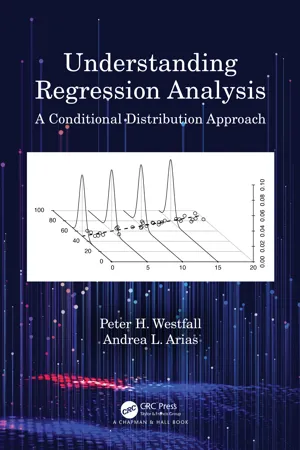
Understanding Regression Analysis
A Conditional Distribution Approach
- 496 pages
- English
- ePUB (mobile friendly)
- Available on iOS & Android
Understanding Regression Analysis
A Conditional Distribution Approach
About this book
Understanding Regression Analysis unifies diverse regression applications including the classical model, ANOVA models, generalized models including Poisson, Negative binomial, logistic, and survival, neural networks, and decision trees under a common umbrella -- namely, the conditional distribution model. It explains why the conditional distribution model is the correct model, and it also explains (proves) why the assumptions of the classical regression model are wrong. Unlike other regression books, this one from the outset takes a realistic approach that all models are just approximations. Hence, the emphasis is to model Nature's processes realistically, rather than to assume (incorrectly) that Nature works in particular, constrained ways.
Key features of the book include:
- Numerous worked examples using the R software
- Key points and self-study questions displayed "just-in-time" within chapters
- Simple mathematical explanations ("baby proofs") of key concepts
- Clear explanations and applications of statistical significance (p-values), incorporating the American Statistical Association guidelines
- Use of "data-generating process" terminology rather than "population"
- Random-X framework is assumed throughout (the fixed-X case is presented as a special case of the random-X case)
- Clear explanations of probabilistic modelling, including likelihood-based methods
- Use of simulations throughout to explain concepts and to perform data analyses
This book has a strong orientation towards science in general, as well as chapter-review and self-study questions, so it can be used as a textbook for research-oriented students in the social, biological and medical, and physical and engineering sciences. As well, its mathematical emphasis makes it ideal for a text in mathematics and statistics courses. With its numerous worked examples, it is also ideally suited to be a reference book for all scientists.
Frequently asked questions
- Essential is ideal for learners and professionals who enjoy exploring a wide range of subjects. Access the Essential Library with 800,000+ trusted titles and best-sellers across business, personal growth, and the humanities. Includes unlimited reading time and Standard Read Aloud voice.
- Complete: Perfect for advanced learners and researchers needing full, unrestricted access. Unlock 1.4M+ books across hundreds of subjects, including academic and specialized titles. The Complete Plan also includes advanced features like Premium Read Aloud and Research Assistant.
Please note we cannot support devices running on iOS 13 and Android 7 or earlier. Learn more about using the app.
Information
Table of contents
- Cover
- Half Title
- Title Page
- Copyright Page
- Table of Contents
- Preface
- Authors
- 1. Introduction to Regression Models
- 2. Estimating Regression Model Parameters
- 3. The Classical Model and Its Consequences
- 4. Evaluating Assumptions
- 5. Transformations
- 6. The Multiple Regression Model
- 7. Multiple Regression from the Matrix Point of View
- 8. R-Squared, Adjusted R-Squared, the F Test, and Multicollinearity
- 9. Polynomial Models and Interaction (Moderator) Analysis
- 10. ANOVA, ANCOVA, and Other Applications of Indicator Variables
- 11. Variable Selection
- 12. Heteroscedasticity and Non-independence
- 13. Models for Binary, Nominal, and Ordinal Response Variables
- 14. Models for Poisson and Negative Binomial Response
- 15. Censored Data Models
- 16. Outliers: Identification, Problems, and Remedies (Good and Bad)
- 17. Neural Network Regression
- 18. Regression Trees
- 19. Bookend
- Index